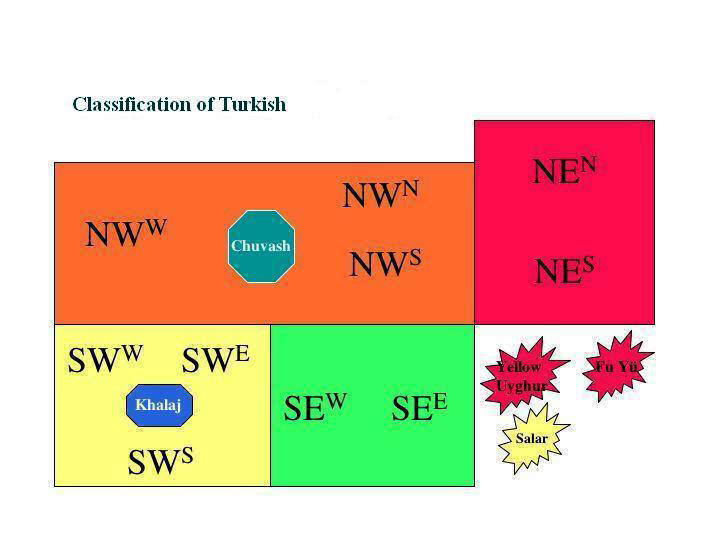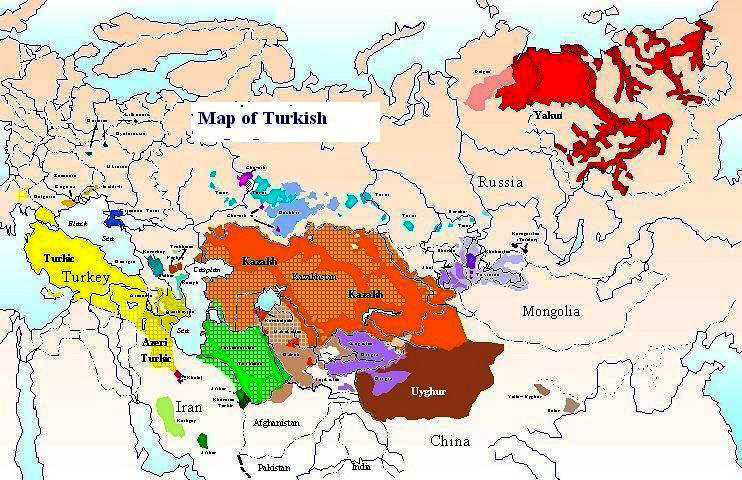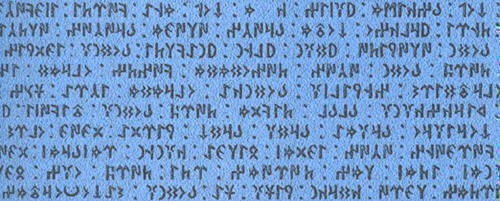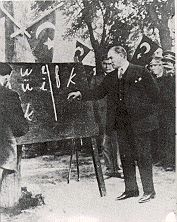|
Turkish (Türkçe) Language
 The Turkish
(Türkçe)
language is spoken over a large geographical area in Europe,
Asia and Africa. It is spoken (a.o.) in the Azeri, the Türkmen, the Tartar, the Uzbek,
the Baskurti, the Nogay, the Kyrgyz, the Kazakh, the Yakuti, the
Cuvas and other dialects. Turkish belongs to the Altaic branch of
the Ural-Altaic family of languages, and thus is closely related to Mongolian,
Manchu-Tungus, Korean, and perhaps Japanese. The Turkish
(Türkçe)
language is spoken over a large geographical area in Europe,
Asia and Africa. It is spoken (a.o.) in the Azeri, the Türkmen, the Tartar, the Uzbek,
the Baskurti, the Nogay, the Kyrgyz, the Kazakh, the Yakuti, the
Cuvas and other dialects. Turkish belongs to the Altaic branch of
the Ural-Altaic family of languages, and thus is closely related to Mongolian,
Manchu-Tungus, Korean, and perhaps Japanese.
Turkish is a very
ancient language going back 5500 to 8500 years. It has a phonetic,
morphological and syntactic structure, and at the same time it possesses
a rich vocabulary.

Turks, Turkish, Classification of
Turkish Language
The dynamic
history of the Turkish-speaking peoples makes it difficult to set up
a classification of modem Turksih languages that combines geographic
and genetic criteria. The following rough scheme represents an
attempt to combine the current area distribution with genetic and
typological features. It primarily distinguishes six branches, some
of heterogeneous origin:
1 A southwestem
(SW) branch, Oghuz Turkish
2 A northwestem (NW) branch, Kipchak Turkish;
3 A southeastem (SE) branch, Uyghur Turkish;
4 A northeastem (NE) branch, Siberian Turkish;
5 Chuvash, representing Oghur or Bulghar Turkish;
6 Khalaj, representing Arghu Turkish.

Subdivisions
The six branches
may be subdivided as in the sequel.
Southwestern
SWw, a West Oghuz
group comprising Turkish, Gagauz and Azerbaijanian Turkish.
SWe, an East Oghuz group comprising Turkmen and Khorasan Turkish.
SWs, a South Oghuz group comprising dialects of Iran (Kashkay,
Sonqori, Aynallu etc.) and Afghanistan (Afshar).
Top
Northwestern
NWw, a West
Kipchak group comprising Kumyk, Karachay, Balkar, Crimean Tatar and
Karaim.
NWn, a North Kipchak or Volga-Ural group comprising (Kazan Tatar,
Mishar, West Siberian) and Bashkir. West Siberian Tatar (Tura,
Baraba, Tomsk, Tümen, Ishim, Irtysh, Tobol, Tara and other dialects)
is partly of different origin.
NWs, a South Kipchak or Aralo-Caspian group comprising Kazakh,
Karakalpak, Kipchak Uzbek and Noghay. In spite of strong genetic
bonds with Altay Turkish of the NEs group, modem Kirghiz may also be
placed in the NWs group, since recent changes have brought it close
to Kazakh. Though the so-called Fu-yü language of Manchuria is
considered a Kirghiz dialect, it is closely related to South
Siberian Turkish, e.g. Yenisey Turkish.
Top
Southeastern
SEw, a western
group comprising modern Uzbek and its various dialects, i.e. Oghuz
Uzbek.
SEe, an eastem group comprising modern Uyghur, Taranchi and
different Eastern Turkish dialects of Kashgar, Yarkand, Khotan,
Kerya, Cherchen, Aksu, Kucha.Turfan, etc. Deviating languages
belonging to the SEe area are Yellow Uyghur, probably of NEs origin,
and Salar, historically developed from the SW branch.
Top
Northeastern
NEn, a North
Siberian group comprising Yakut (Sakha) and Dolgan.
NEs, a heterogeneous South Siberian group comprising three
subgroups:
1 Sayan Turkish consisting of Tuvan (Soyot, Uryankhai) and Tofa (Karagas);
2 Yenisey Turkish comprising Khakas, Shor and related dialects (Saghay
Qaca, Qizil);
3 Chulym Turkish comprising dialects such as Küerik;
4 Altay Turkish comprising Altay (Oyrot) and dialects such as Tuba,
Qumanda, Qu, Teleut, Telengit.
Some Altay Turkish dialects are rather close to Kirghiz (NWs). As
noted above, Yellow Uyghur may be of NEs origin, and Fu-yü displays
similarities with Yenisey Turkish.
Top

Top
A Brief History of Turkish Language
The Turkish
language is spoken over a large geographical area in Europe,
Asia and Africa. It is spoken in the Azeri, the Türkmen, the Tartar, the Uzbek,
the Baskurti, the Nogay, the Kyrgyz, the Kazakh, the Yakuti, the
Cuvas and other dialects. Turkish belongs to the Altaic branch of
the Ural-Altaic family of languages, and thus is closely related to
Mongolian, Manchu-Tungus, Korean, and perhaps Japanese. Some
scholars have maintained that these resemblances are not
fundamental, but rather the result of borrowings, however
comparative Altaistic studies in recent years demonstrate that the
languages we have listed all go back to a common Ur-Altaic.
Turkish is a very
ancient language going back 5500 to 8500 years. It has a phonetic,
morphological and syntactic structure, and at the same time it
possesses a rich vocabulary. The fundamental features, which
distinguish the Ural-Altaic languages from the Indo-European, are as
follows:
- 1. Vowel harmony, a feature of
all Ural-Altaic tongues.
- 2. The absence of gender.
- 3. Agglutination
- 4. Adjectives precede nouns.
- 5. Verbs come at the end of
the sentence.
Top
Written
Turkish
The oldest
written records are found upon stone monuments in Central Asia, in
the Orhon
Yenisey and Talas regions within the boundaries of present-day
Mongolia. These were erected to Bilge Kaghan (735), Kültigin (732),
and the vizier Tonyukuk (724-726). These monuments document the
social and political life of the Gokturk Dynasty.
After the waning
of the Gokturk state, the Uighurs produced many written texts that
are among the most important source works for the Turkish language.
The Uighurs abandoned shamanism (the original Turkish religion) in
favor of Buddhism, Manichaeanism and Brahmanism, and translated the
pious and philosophical works into Turkish. Examples are Altun Yaruk,
Mautrisimit, Sekiz Yükmek, Huastunift. These are collected in
Turkische Turfan-Texte. The Gokturk inscriptions, together with
Uighur writings, are in a language called by scholars Old Turkish.
This term refers to the Turkish spoken, prior to the conversion to
Islam, on the steppes of Mongolia and Tarim basin.

A sample of
Gokturk Inscriptions, commissioned by Gokturk Khans. One of several
in Mongolia, near river Orkhun, dated 732-735. Example statement
(from Bilge Khan): "He (Sky God or "Gok Tanri") is the one who sat
me on the throne so that the name of the Turkish Nation would live
forever."
The Turkish that
developed in Anatolia and Balkans in the times of the Seljuks and
Ottomans is documented in several literary works prior to the 13th
century. The men of letters of the time were, notably, Sultan Veled,
the son of Mevlana Celaleddin-i Rumi, Ahmed Fakih, Seyyad Hamza,
Yunus Emre, a prominent thinker of the time, and the famed poet,
Gulsehri. This Turkish has a dialect which falls into the
southwestern dialects of the Western Turkish language family and
also into the dialects of the Oguz Türkmen language group. When the
Turkish spoken in Turkey is considered in a historical context, it
can be classified according to three distinct periods:
1. Old Anatolian
Turkish (old Ottoman - between the 13th and the 15th centuries)
2. Ottoman
Turkish (from the 16th to the 19th century)
3. 20th century
Turkish
The Turkish
Language up to the 16th Century With the spread of Islam among the
Turks from the 10th century onward, the Turkish language came under
heavy influence of Arabic and Persian cultures. The "Divanü-Lügati't-Türk"
(1072), the dictionary edited by Kasgarli Mahmut to assist Arabs to
learn Turkish, was written in Arabic. In the following century, Edip
Ahmet Mahmut Yükneri wrote his book "Atabetü'l-Hakayik", in Eastern
Turkish, but the title was in Arabic. All these are indications of
the strong influence of the new religion and culture on the Turks
and the Turkish language. In spite of the heavy influence of Islam,
in texts written in Anatolian Turkish the number of words of foreign
origin is
minimal. The most important reason for this is that during the
period mentioned, effective measures were taken to minimize the
influence of other cultures. For example, during the Karahanlilar
period there was significant resistance of Turkish against the
Arabic and Persian languages. The first masterpiece of the Muslim
Turks, "Kutadgu Bilig" by Yusuf Has Hacib, was written in Turkish in
1069. Ali Nevai of the Çagatay Turks defended the superiority of
Turkish from various points of view vis-à-vis Persian in his book
"Muhakemetül-Lugatein", written in 1498.
During the time
of the Anatolian Seljuks and Karamanogullari, efforts were made
resulting in the acceptance of Turkish as the official language and
in the publication of a Turkish dictionary, "Divini Turki", by
Sultan Veled (1277). Ahmet Fakih, Seyyat Hamza and Yunus Emre
adopted the same attitude in their use of ancient Anatolian Turkish,
which was in use till 1299. Moreover, after the emergence of the
Ottoman Empire, Sultan Orhan promulgated the first official document
of the State, the "Mülkname", in Turkish. In the 14th century,
Ahmedi and Kaygusuz Abdal, in the 15th century Süleyman Çelebi and
Haci Bayram and in the 16th century Sultan Abdal and Köroglu were
the leading poets of their time, pioneering the literary use of
Turkish. In 1530, Kadri Efendi of Bergama published the first study
of Turkish grammar, "Müyessiretül-Ulum".
The outstanding
characteristic in the evolution of the written language during these
periods was that terminology of foreign origin was accompanied with
the indigenous. Furthermore, during the 14th and 15th centuries
translations were made particularly in the fields of medicine,
botany, astronomy, mathematics and Islamic studies, which promoted
the introduction of a great number of scientific terms of foreign
origin into written Turkish, either in their authentic form or with
Turkish transcriptions. Scientific treatises made use of both
written and vernacular Turkish, but the scientific terms were
generally of foreign origin, particularly Arabic.
Top
The Evolution of Turkish since the 16th
Century
The mixing of
Turkish with foreign words in poetry and science did not last
forever. Particularly after the 16th century foreign terms dominated
written texts, in fact, some Turkish words disappeared altogether
from the written language. In the field of literature, a great
passion for creating art work of high quality persuaded the ruling
elite to attribute higher value to literary works containing a high
proportion of Arabic and Persian vocabulary, which resulted in the
domination of foreign elements over Turkish. This development was at
its extreme in the literary works originating in the Ottoman court.
This trend of royal literature eventually had its impact on folk
literature, and folk poets also used numerous foreign words and
phrases. The extensive use of Arabic and Persian in science and
literature not only influenced the spoken language in the palace and
its surroundings, but as time went by, it also persuaded the Ottoman
intelligentsia to adopt and utilize a form of palace language
heavily reliant on foreign elements. As a result, there came into
being two different types of language. One in which foreign elements
dominated, and the second was the spoken Turkish used by the public.
From the 16th
to the middle of the 19th century, the Turkish used in science and
literature was supplemented and enriched by the inclusion of foreign
items under the influence of foreign cultures. However, since there
was no systematic effort to limit the inclusion of foreign words in
the language, too many began to appear. In the mid-19th century,
Ottoman Reformation (Tanzimat) enabled a new understanding and
approach to linguistic issues to emerge, as in many other matters of
social nature. The Turkish community, which had been under the
influence of Eastern culture, was exposed to the cultural
environment of the West. As a result, ideological developments such
as the outcome of reformation and nationalism in the West, began to
influence the Turkish community, and thus important changes came
into being in the cultural and ideological
life of the country.
The most
significant characteristic with respect to the Turkish language was
the tendency to eliminate foreign vocabulary from Turkish. In the
years of the reformation, the number of newspaper, magazines and
periodicals increased and accordingly the need to purify the
language became apparent. The writing of Namik Kemal, Ali Suavi,
Ziya Pasa, Ahmet Mithat Efendi and Semsettin Sami, which appeared in
various newspapers, tackled the problem of simplification. Efforts
aimed at "Turkification" of the language by scholars like Ziya
Gökalp became even more intensive at the beginning of the 20th
century. Furthermore, during the reform period of 1839, emphasis was
on theoretical linguistics whereas during the second constitutional
period it was on the implementation and use of the new trend.
Consequently new linguists published successful examples of the
purified language in the periodical "Genç Kalemler" (Young Writers).
Top
The Republican Era and Language Reform
With the
proclamation of the Republic in 1923 and after the process of
national integration in the 1923-1928 period, the subject of
adopting a new alphabet became an issue of utmost importance.
Mustafa Kemal Atatürk had the Latin alphabet adapted to the Turkish
vowel system, believing that to reach the level of contemporary
civilization, it was essential to benefit from western culture. The
creation of the Turkish Language Society in 1932 was another
milestone in the effort to reform the language. The studies of the
society, later renamed the Turkish Linguistic Association,
concentrated on making use again of authentic Turkish words
discovered in linguistic surveys and research and bore fruitful
results.

At present, in
conformity with the relevant provision of the 1982 Constitution, the
Turkish Language Association continues to function within the
organizational framework of the Atatürk High Institutio Culture,
Language and History. The essential outcome of the developments of
the last 50-60 years is that whereas before 1932 the use of
authentic Turkish words in written texts was 35-40 percent, this
figure has risen to 75-80 percent in recent years. This is concrete
proof that Atatürk's language revolution gained the full support of
public.
Top
Related Links and Sources
-
Turkish Languages
-
Original Source of Colour Coded Turkish Language Map,
Prof. Jost Gippert
-
The History
of Turkic (1998), Prof. Lars Johanson.
-
The Turkic
Languages. London, New York: Routledge, 81-125, Prof. Lars
Johanson & Prof. Éva Ágnes Csató
-
Ministry of
Foreign Affairs/The Republic of Turkey
-
Organization of Turkish Culture
-
Chuvash Cultural Portal
-
Turkish to Turkish Dictionary
-
Turkish
Language
& Native Americans

TransAnatolie Tour
|












